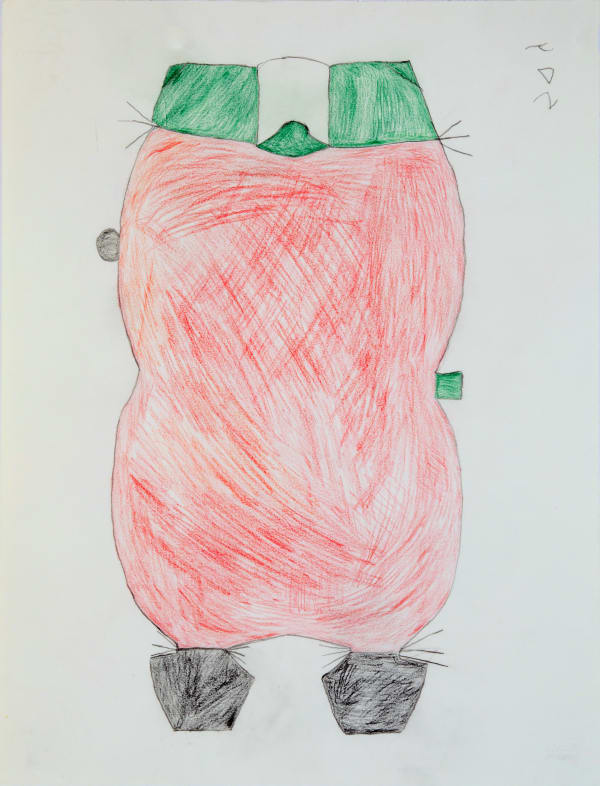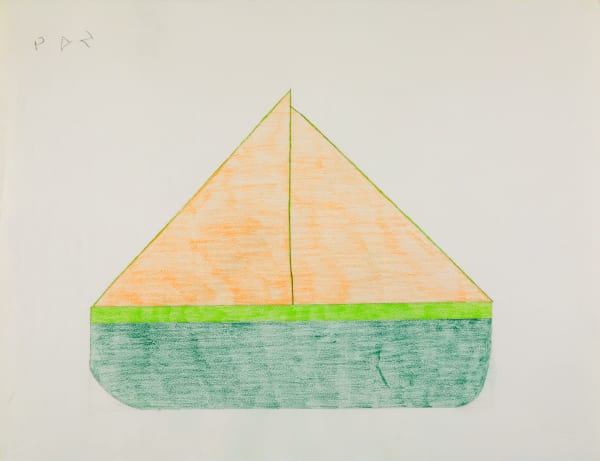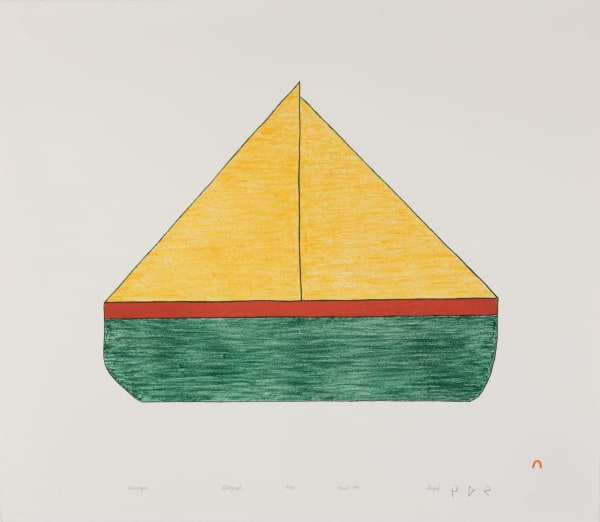-
Sheojuk Etidlooie
A Brief but Exceptional CareerSheojuk Etidlooie’s short but remarkable career began in 1993 when, despite not having tried her hand at drawing before, Sheojuk was awarded first prize at an Anglican Church Christmas event in Kinngait for her drawing of a qulliq. Her bold and colourful interpretations attracted the attention of Jimmy Manning, then the West Baffin Cooperative manager, who encouraged Sheojuk to continue her art. In 1994, her designs were made into lithographs for inclusion in the Cape Dorset annual print collection. She was soon a major figure in Kinngait's art community. In 1998, her drawings accounted for almost half the annual print collection.
Although she was born in 1932 to a hunting family near Kinngait, she moved away with her first husband in the 1950s and continued to live a traditional lifestyle. Simultaneously, the fledgling printmaking studio began to take shape in Cape Dorset under James Houston. As such, Sheojuk missed the first flourish of graphic art in Kinngait. She returned to Dorset in the early 1980s and, having absorbed the lessons offered by her artistic predecessors, a decade later, Sheojuk tore up the rules of representation, her style sharply departing from that of other Cape Dorset elders like Kananginak Pootoogook and Kenojuak Ashevak. Despite having one of the shortest active careers, Sheojuk produced a body of work that is as outstanding and idiosyncratic as those of her more established counterparts from Kinngait.
Sheojuk Etidlooie as Remembered by Pat Feheley
I first encountered the unique imagery found in Sheojuk’s works from the translations of her images into prints. Then, during a trip to Cape Dorset in the late 1990s, I had the opportunity to see her original drawings, which to me were even more immediate and enchanting. I was able to complete an extensive interview with Sheojuk preparatory to organizing the first Feheley Fine Arts solo exhibition of her original drawings in 1998. The gallery invited Sheojuk to travel to Toronto, where she was welcomed by collectors from across Canada and the United States. There are wonderful memories from that trip, including her first in-person viewing of the Santa Claus parade, which she found very funny.
Soon after this we began work on her second exhibition. I travelled to Cape Dorset to take part in the festivities for the creation of the Territory of Nunavut on April 1, 1999. During this trip I also completed extensive interviews with Sheojuk with works selected for her second drawing exhibition at Feheley Fine Arts. We fit this in around her schedule of demonstrating traditional life for local schoolchildren. Sadly she passed away suddenly of pneumonia just months before her second solo drawing exhibition. This exhibition, held in the fall of 1999, became a commemorative show in which the very few oil pastels completed by the artist were presented.
To discuss making arrangements to view these works in person, or to obtain condition reports and additional images, please contact info@firstarts.ca or 647-286-5012.
Graphic works are unframed unless otherwise indicated.
Works
-
Animals
Animals feature prominently in Sheojuk’s works. Certain Arctic species figure repeatedly in her drawings, such as owls and other birds, seals, fish, yet she conveys to image each a sense of individuality. Untitled (Green Owl Fledgling) c. 1995-96 is drawn in Sheojuk’s hallmark style; the artist outlines the subject in graphite lines then fills the enclosed space with energetic strokes of pencil crayon. The personality of this small bird comes to life in Sheojuk’s deceptively simple yet lively rendering of his pose. He presents as highly alert, his intense gaze meeting ours directly and goes straight to the nerve of being. Untitled (Falcon in Flight) of c. 1995-6 is decidedly more naturalistic, seemingly a product of careful observation. The falcon’s muscles are tensed as her massive, onyx-coloured wings soar out behind her as she surges forward against the Arctic gales. The familiarity and unguarded manner with which Sheojuk captures her animal subjects is, arguably, unmatched in Cape Dorset graphic art. It might be more apt to compare them, for example, to the wonderfully quirky birds of the Cape Dorset sculptor Latcholassie.
-

SHEOJUK ETIDLOOIE (1932-1999) KINNGAIT (CAPE DORSET)
Untitled (Green Owl Fledgling), 1995-6
coloured pencil over graphite on paper, 26 x 20 in (66 x 50.8 cm)
signed, "ᓯᐅᔪ". -
-
Abstract Forms
Rather unique to Sheojuk’s works are her abstracted images, which include organic and architectural elements, or a combination of both. A testament to her vivid imagination, each of these images is alive with her particular and distinctive style. Sheojuk’s “abstract” drawings are uncanny and enigmatic. They present highly ambiguous forms conjured up in the unique mind of the artist. John Westren’s elegant description of Sheojuk’s imagery is as apt for her abstract drawings as it is for her drawings of animals in his essay “Toward the Millennium” in Leslie Boyd Ryan’s 2007 book Cape Dorset Prints: A Retrospective:
It was as if she had never seen any other art before. Free from any preconceptions or models of the way things should be done, Sheojuk developed an original visual language to tell us what we already know: that most of us have two eyes; that we move around things; and that foreshortening, perspective, and three-dimensional modelling are all tricks and illusions when fixed on a flat sheet of paper (p. 245).
Untitled (Skin Tent in Green and Red) from c. 1995-96 is a fine example of an image by Sheojuk whose title seems to pose more questions than answers. It’s as if the artist were trying to trick us or riddle us in the manner of Marcel Duchamp or René Magritte. As with many of Sheojuk’s “abstract” works, the object is presented in a “splayed” perspective – deliberately flattened or spread apart so that the viewer sees everything and nothing at the same time.
Works like Untitled (Powerful Bird), 1997-99 serve as an example of Sheojuk’s distinctive abstract style as it applies to more intelligible figures – if you know what to look for. The hatched “v” lines that make up the composition, reminiscent of the stitched lines of embroidery works, imbue the work with a sense of theatricality, their forms rushing toward and away from one another. One could argue that the embroidery serves to emphasize the central bird motif, but it could be just as easily argued that it disguises it. Once the viewer notes the webbed feet of the bird, its spindly legs, torso, neck and head reveal themselves, and suddenly the angular structure enveloping the bird takes on a whole new layer of meaning.
-
-
Prints
Sheojuk’s rich imagination and bold style lend themselves to spectacular prints in a multitude of mediums. In her short artistic career, she contributed an astonishing number of prints to the annual Kinngait collections. In 1994, the year of her inaugural inclusion, Sheojuk’s Upinnguaq (Like an Owl), 1994 was featured on the cover. In 1996, a scarlet fowl by the artist would again be featured on the cover, this time her rather regal Raven in Red.
Amongst the highlights of the prints on offer is Young Caribou, 1999. Here a lone calf is pictured as wobbling on its stick-thin legs in a compressed space, his mouth agape in a bleat. The image is inked in brilliant but naturalistic colours by Arnaqu Ashevak, an artistic strategy that reinforces the concept behind Sheojuk’s image - a celebration of birth and life in the Arctic.
The impassioned drama of the Shaman's Trance, 1998 is accomplished to a dazzling degree in by the etching and aquatint medium. The searing brilliance of the figure’s richly red countenance and hands that glow like hearth fires, are pitted against a vastness of monochromatic greys which are keyed as agitated and whipped up to represent the essence of the shaman’s reverie.
One of the most sought-after works at its release in 1999 was Bird in Winter Night, and it is easy to understand why. We cannot miss the dominant and cool blues of the bird, whose body shimmers like a gemstone against the expanse of lithographed black.
In this exhibition we are pleased to present the remarkable semi-abstract lithograph Ummiagoa (Toy Boat), 1995 #31, alongside Sheojuk’s original drawing that may have inspired it. As John Westren so eloquently puts it, “At first glance, Sheojuk’s images seem childish and naïve, but with only a few expressive lines and shapes, Sheojuk tells us more about an object than many of the most detailed, finely rendered efforts can tell us” (op. cit.).
-
-
Join our mailing list
* denotes required fields
We will process the personal data you have supplied in accordance with our privacy policy (available on request). You can unsubscribe or change your preferences at any time by clicking the link in our emails.
































![SHEOJUK ETIDLOOIE (1932-1999) KINNGAIT (CAPE DORSET) Printmaker: STUDIO PM, Montreal Chine Colle Suite [The Complete Suite of Four],, 1999 (Special Release) etching and aquatints, 25.75 x 19.75 in (65.4 x 50.2 cm) / plate 13.25 x 12 in (33.7 x 30.5 cm) and smaller each 8/20](https://artlogic-res.cloudinary.com/w_600,c_limit,f_auto,fl_lossy,q_auto/artlogicstorage/firstarts/images/view/891788431f7a6e15de67aa4086ec8db2j/firstarts-sheojuk-etidlooie-1932-1999-kinngait-cape-dorset-chine-colle-suite-the-complete-suite-of-four-1999-special-release.jpg)